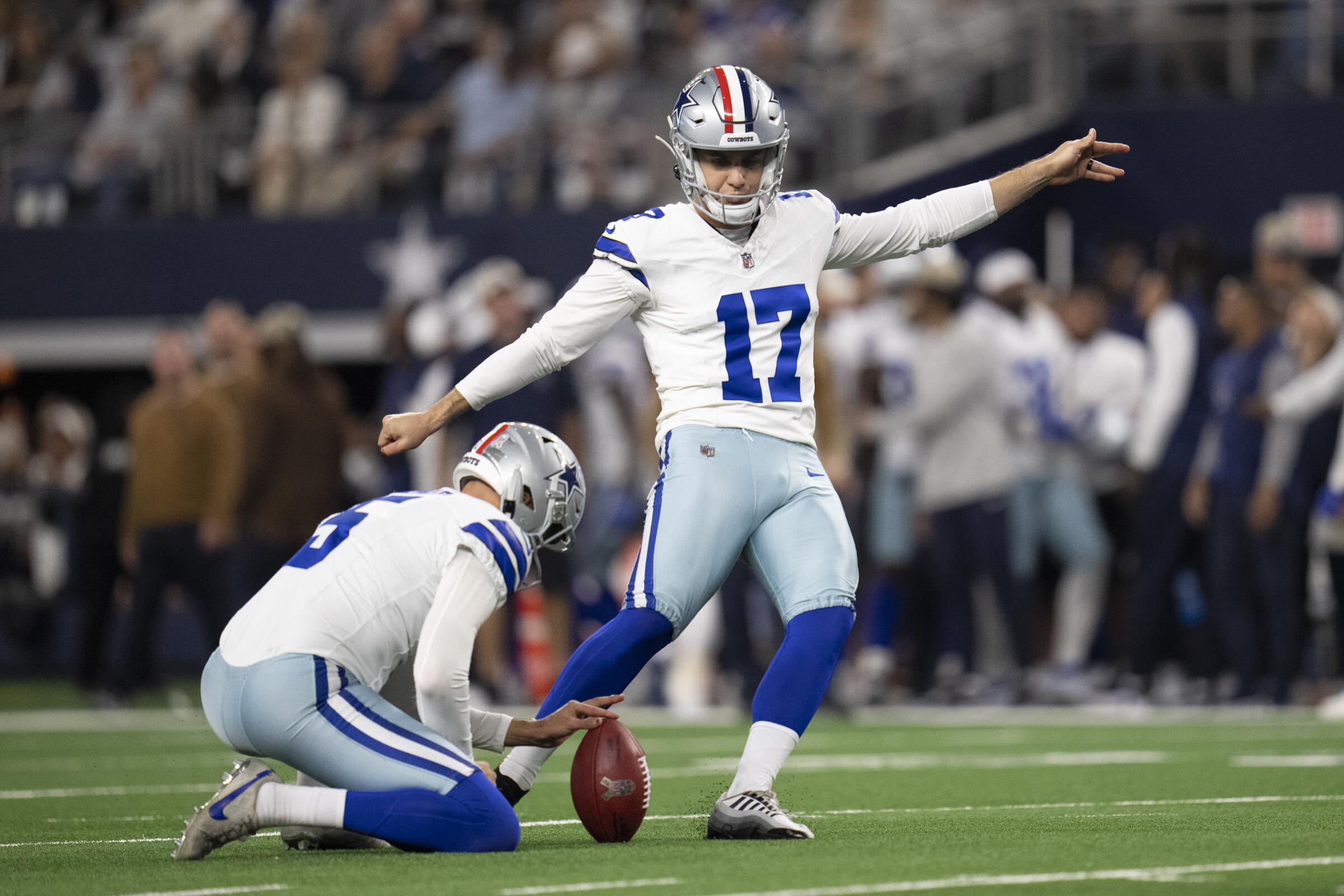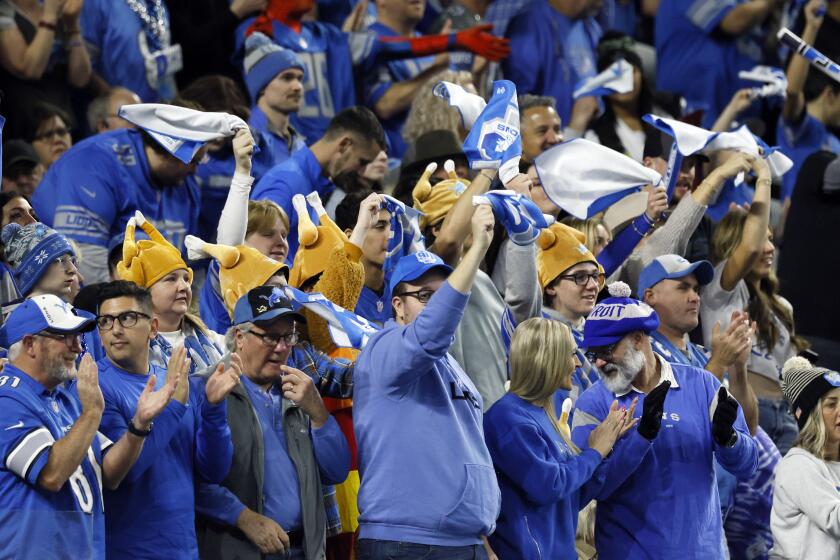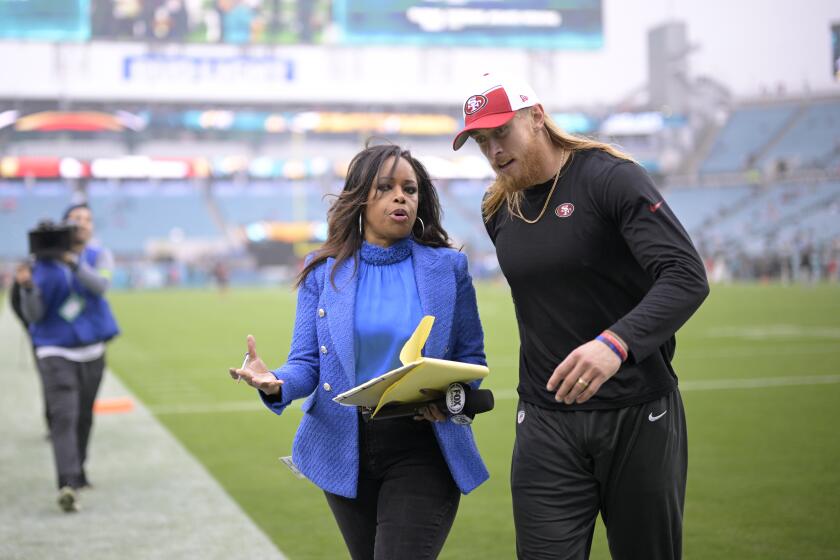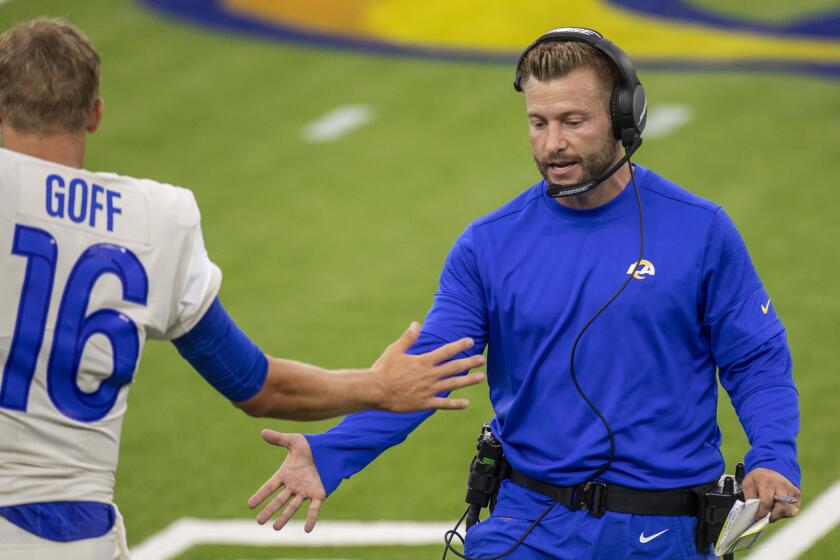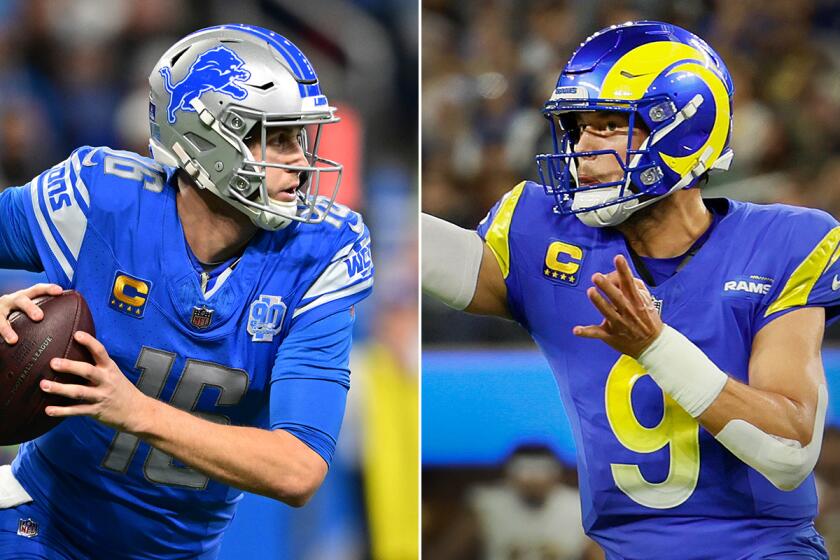Kevin Baxter writes about soccer and hockey for the Los Angeles Times. He has covered seven World Cups, five Olympic Games, six World Series and a Super Bowl and has contributed to three Pulitzer Prize-winning series at The Times and Miami Herald. An essay he wrote in fifth grade was voted best in the class. He has a cool dog.
- Share via
1
It was Brandon Aubrey’s wife Jenn who first realized her husband might have been playing the wrong sport.
Two years after being selected in the first round of the MLS SuperDraft, and a year after retiring from soccer without appearing in an MLS match, the Aubreys were watching an NFL game on TV when a kicker set up for a field-goal try.
You could do that, Jenn told him.
Unconvinced, Aubrey grabbed a football and headed to the nearest high school field, where he began booming 60-yard kicks.
Maybe he could do this.
Four years later, there’s no longer any doubt. Aubrey set an NFL rookie record this season by making his first 35 field-goal tries for the Dallas Cowboys, becoming the first kicker to make both a 59- and 60-yard kick in the same game. He also led the league in scoring, with 157 points, in field goals made, with 36, and in touchbacks, with a league-record 99, making him the best at his craft in what has been the greatest year for kickers in NFL history.
The Lions haven’t had a home playoff game since 1994, so the psyched Detroit crowd is going to make plenty of noise and that could be an issue for the Rams
There were a record 911 field goals this season, with kickers converting on nearly 86% of their tries, the second-best percentage ever. Of those successful kicks, 158 of them — including 10 by Aubrey — were from at least 50 yards; that, too, is the most ever. And kickers combined to account for nearly a third of all points scored in the regular season.
“Having a great kicker is an absolute weapon,” said Chris Sailer, who runs Burbank-based Chris Sailer Kicking, one of the largest and most successful kicking schools in the country. “The number of points the kicker scores for a team now is huge. Fifty-yard field goals, 60-yard field goals, there’s so many guys that can do that now.
“There’s a sort of proficiency at that position, which makes it absolutely huge for NFL teams to have a top guy.”
Aubrey is certainly that, having earned a Pro Bowl selection while leading the Cowboys to the playoffs, which they’ll open at home Sunday against the Green Bay Packers. All that comes as no surprise to Brian Egan, a former Mississippi State kicker who guided Aubrey’s transition from unemployed soccer player with a big leg into a record-setting kicker.
“I had a lot of confidence in him, that if he did get an opportunity at this level he would go out and have a promising career,” said Egan, 33, a private kicking coach in suburban Dallas. “Just getting there was the hard part. How do we take [someone] who’s never played at this level, or even in college, and get the opportunity to be one of 32 in the world?
“If he got his opportunity, I thought he could run with it. And that’s what he did.”
Aubrey, who declined to be interviewed for this story, isn’t the first former professional soccer player to find success in the NFL. He’s not the only first-round MLS draft pick to do so. High school goalkeeper Josh Lambo, a former youth international and once a trialist with Everton of the English Premier League, was the eighth overall selection in the 2008 MLS SuperDraft but played only six games with the second-tier Tampa Bay Rowdies before quitting soccer at 21 to enroll at Texas A&M.
In 2012, he walked on to the Aggies’ football team, became the No. 1 kicker a year later, and went on to play for four NFL teams, booting a 59-yard field goal in his final season.
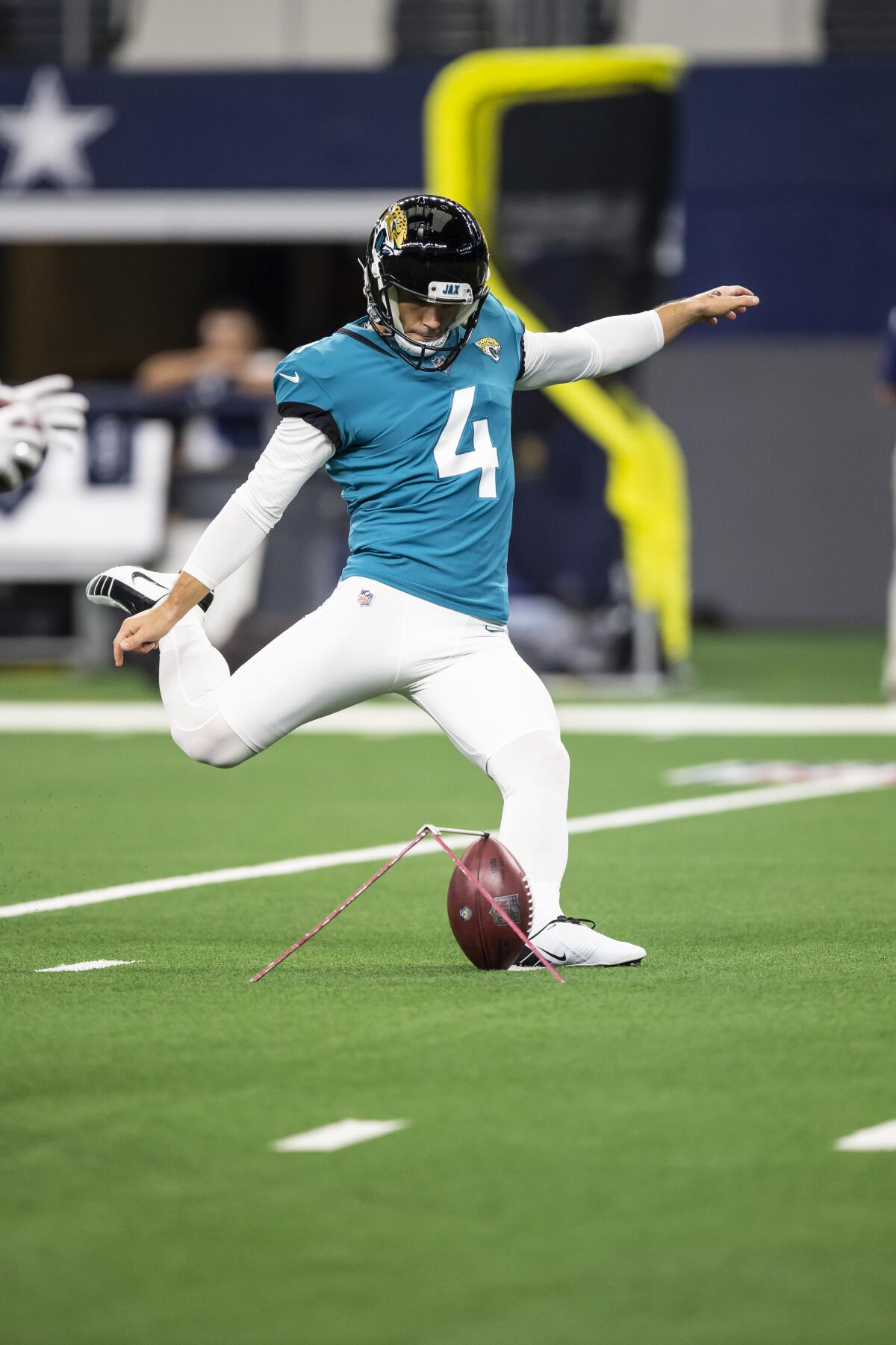
(Brandon Wade / Associated Press)
Like Lambo, Aubrey had never played football before retiring from soccer. After a stellar college career as a defender at Notre Dame, he was the 21st player selected in the 2017 MLS SuperDraft, going to Toronto with the penultimate pick of the first round. Also like Lambo he never played in an MLS game, spending a season with Toronto’s affiliate in the second-tier USL, then signing with USL rival Bethlehem Steel, which released him after one season.
“I didn’t think he was going to be, from what I had seen, at an MLS level, mainly from an athletic standpoint,” said Galaxy assistant Jason Bent, who coached Aubrey during his lone season with Toronto’s reserve team. “He wasn’t very quick, wasn’t quick in the turn — which for center backs is extremely important. I felt maybe USL might have been his level and he could have continued his career. But he made a different choice.”
That choice was to retire from soccer at 24. He planned to put his Notre Dame degree to work as a software engineer, but his newlywed wife, who had played lacrosse for the Fighting Irish, urged him to try football first. The tackle kind. So Aubrey asked Egan for help.
“Taking somebody who’s never done something at a certain level, it’s more about just mastering the muscle memory and things like that,” said Egan, whose kicking school is less than 20 miles from where Aubrey attended high school in Plano, Texas. “To achieve the level of competition that Brandon was working toward, we knew guys had some years on us when it came to repetition.”
Among the things Aubrey had to become comfortable with was wearing a helmet and pads, so he took a helmet home to wear around the house. He had nothing to learn about the hard work required to be a world-class athlete, however.
Fox Sports sideline reporter Pam Oliver, who has shrugged off a litany of obstacles to set a record for most NFL games called, isn’t ready to retire.
“Brandon took what he had from soccer, being a professional, and just translated it into learning something new. It was a different process,” said Egan, who trained Aubrey for about two years before sending him off to audition for coaches at showcase events around the country.
The Birmingham Stallions of the USFL were the first team to give him a shot, signing him in April 2022. Aubrey rewarded them by making 18 of 22 field-goal tries and averaging 66.5 yards on a league-leading 55 kickoffs. He was even better the next season, missing just one of 15 field-goal attempts as the Stallions won a second straight USFL title.
The team released him two days after last summer’s championship game, allowing Aubrey to sign with his hometown team, the Cowboys. A month later Dallas cut journeyman kicker Tristan Vizcaino and handed the job to the 28-year-old rookie.
The whirlwind success of Aubrey and Indianapolis Colts’ kicker Matt Gay, who once kicked for the Rams, could lead more NFL teams to give soccer players a chance. Gay, 29, who was enrolled in the youth national soccer team’s residency program, then played two seasons of college soccer before walking on to the football team at Utah, set career highs for field goals (33) and field goals of at least 50 yards (eight) this season, his fifth in the NFL. Sailer, the Burbank kicking coach who enrolled at UCLA on a joint football-soccer scholarship, says he believes recruiting kickers from soccer teams would hardly be a gamble on the NFL’s part.

(Michael Conroy / Associated Press)
“Growing up as soccer players you’re developing that leg strength and that motion over years. It’s a very natural transition,” said Sailer, 47, the son of German immigrants who played both soccer and football at Sherman Oaks Notre Dame High and had a short professional career spent mostly in arena football.
“There’s definitely things that are different when it comes to kicking a soccer ball versus kicking a football. But in general, the ability to have that strength, have that muscle memory, all those things combined really is what made the transition so easy.”
Sailer likens the approach in soccer-style kicking — a 2½-step approach from behind and to one side of the holder — to a golf swing in that it is repeatable despite there are a lot of moving pieces. Most soccer players have been doing that since they were 4 or 5, similar to setting up for free kicks. What’s different, he said, is learning to elevate the ball quickly to get it over leaping defensive linemen.
“In soccer you’re always trained to keep the ball low. Especially when you’re shooting,” Sailer said. “So it does take some time to be able to teach your body to actually swing up through the ball as opposed to being over the top of the ball.”
Rams-Lions playoff matchup brings back ugly memories of Rams’ Sean McVay rejecting Jared Goff in trade to bring Matthew Stafford, Super Bowl to L.A.
The downside to the record success of NFL kickers is near-perfection has now become the expectation, meaning a couple of missed kicks at key moments can earn a player his release. That’s why 41 players have attempted field goals or extra points this season with the New York Giants employing four kickers. The Rams, Detroit Lions, New York Jets and Cleveland Browns were among the teams that used more than one.
“That just speaks to the evolution of the position and really how these guys are taking themselves just from being kickers from back in the day to now actually being legit NFL-caliber athletes,” Egan said. “They are the smaller guys on the team, but [with] the efficiency that we have, your percentage of a 60-yard field goal are significantly higher than throwing a Hail Mary at the end of the game.”
Although so-called soccer-style kickers are ubiquitous in college and professional football today — Mark Moseley, the last “conventional” or straight-on toe kicker, retired in 1986 — the technique was considered something of a quirky fad when a Hungarian immigrant named Pete Gogolak debuted with the AFL’s Buffalo Bills in 1964.
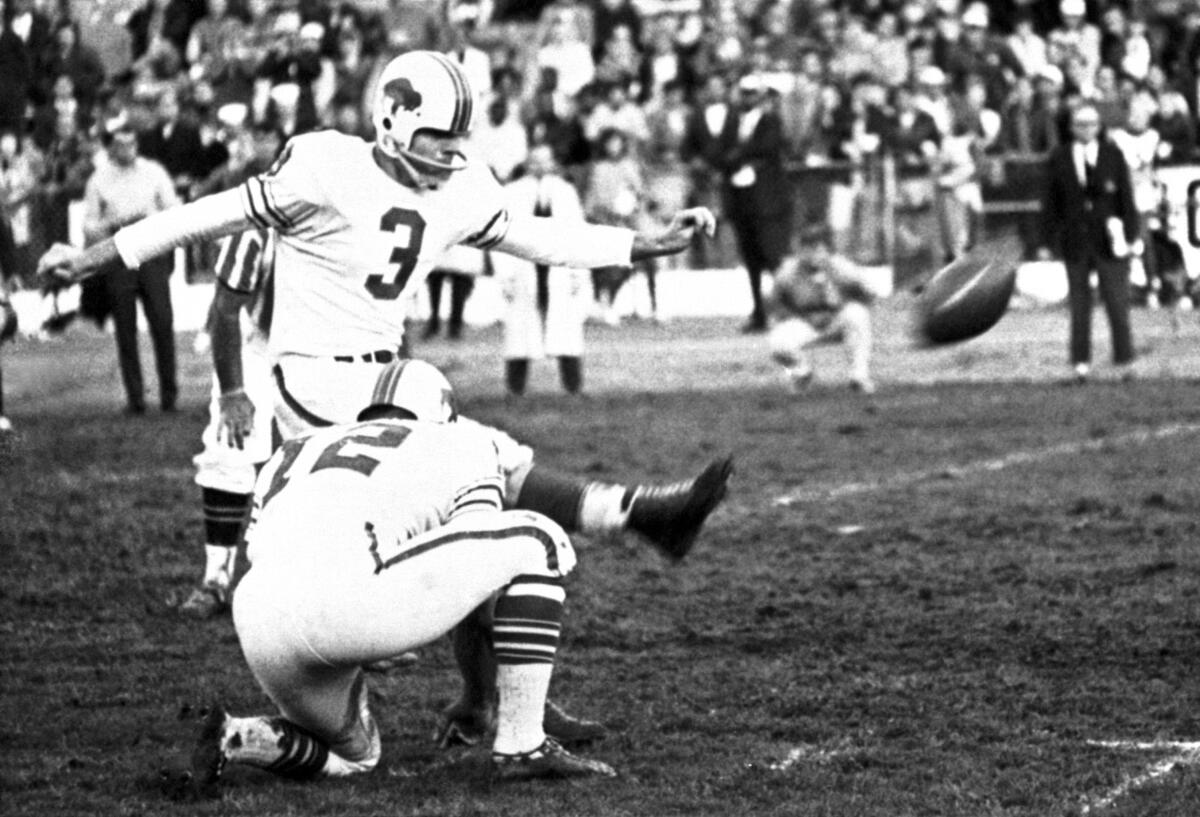
(Associated Press)
Gogolak, who grew up playing soccer, switched to football in the U.S. because his high school didn’t have a soccer team. But he kept the kicking style, addressing the ball from an angle and hitting it with the instep of his foot. Striking with the instep rather than just the toe of the boot allows kickers to put more surface area on the ball, giving them more control over the flight path. Approaching from the side allows the kicker’s hip to rotate, creating more velocity and power, adding height and up to 20 yards in distance to each kick.
The unconventional method was perfect for the upstart AFL, which was then battling the established NFL for attention. Gogolak proved to be more than a novelty; in his second season, he led the league with 28 field goals and was second with 115 points, helping the Bills to a second straight AFL title.
Gogolak never matched those numbers again, but he had introduced the biggest change to football since the forward pass. By 1971, the year after the NFL-AFL merger, the league’s 16 top scorers were all kickers, led by Miami’s Garo Yepremian, a Cypriot immigrant who attended college on a soccer scholarship and turned down an offer from Arsenal to play in the NFL.
Kickers were now specialists, not linemen who moonlighted on fourth down. And they were more accurate and converting from longer distances than before, with nine kickers making field goals of at least 50 yards. Suddenly crossing midfield put teams in scoring position.
NFL wild-card weekend will feature plenty of intriguing matchups, but the looming battle between Matthew Stafford and Jared Goff is the cherry on top.
The NFL responded by literally moving the goal posts, pushing them back 10 yards to the other side of the end zone in 1974. By the time Moseley retired, soccer-style kickers were making more than two-thirds of their field-goal attempts and 21 of the 28 teams had kickers who converted from at least 50 yards.
Now comes a new generation, led by Aubrey and Gay, that is further revolutionizing the game by bringing not just soccer skills, but a soccer mindset as well. It’s just the start, said Bent, the Galaxy assistant.
“Stories like this, you’re going to start to see more of that,” he promised. “The mental fortitude, the mental strength, that’s going to be a big part of it.
“You would have thought it might have happened before because there certainly is some transferable skills. But I’m sure it’s going to happen more in the future. This is pretty groundbreaking.”
